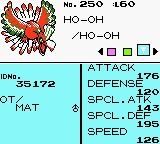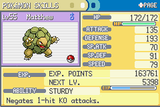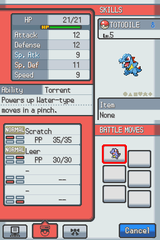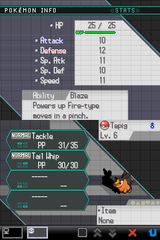Stat: Difference between revisions
m (→Example: grammar) |
m (→Example: grammar) |
||
| Line 240: | Line 240: | ||
=====Example===== | =====Example===== | ||
Consider a Level 78 {{p|Garchomp}} with the following | Consider a Level 78 {{p|Garchomp}} with the following IVs and EVs and an '''Adamant''' nature: | ||
{| class="roundy" style="margin:auto; text-align:center; background: #{{Dragon color dark}}; border: 5px solid #{{Dragon color}};" | {| class="roundy" style="margin:auto; text-align:center; background: #{{Dragon color dark}}; border: 5px solid #{{Dragon color}};" | ||
Revision as of 23:40, 10 August 2014

|
It has been suggested that this article be moved to Stat. Please discuss whether or not to move it on its talk page. |
- HP and Hit Points redirect here. For the move commonly referred to in competitive battling as "HP", see Hidden Power. For the Pokémon Trading Card Game set commonly abbreviated as "HP," see EX Holon Phantoms. For HP in the Trading Card Game, see Glossary of terms.
Stats, short for statistics, determine certain aspects of battles in the games. Stats may also refer to the numerical values of each field in regards to individual Pokémon.
List of stats
Permanent stats
Hit Points
- "HP" redirects here. For the move sometimes abbreviated as "HP" in competitive play, see Hidden Power (move).
Hit Points, or HP for short, determine how much damage a Pokémon can receive before fainting. It is the most visible of the stats in battle, appearing both graphically (as a bar that is green, yellow, or red depending on how much HP is left) and as a current/total amount below the bar. The average base HP stat is 68 for all Pokémon, and the average for all fully evolved Pokémon is 80.
If a Pokémon has more than half of its HP, its HP bar remains green. If the Pokémon has between one-fifth and half of its HP, the bar will turn yellow. If a Pokémon has less than one-fifth of its HP remaining, the bar will turn red and a beeping sound (Generations I-IV and VI), a change of battle music with the beep as a metronome (Generation V), or a series of 4 beeping sounds before fading away will notify the player that his or her Pokémon is in danger of fainting. This beeping will continue until the Pokémon is switched out to another Pokémon which has at least one-fifth of its HP, has its HP raised to one-fifth or higher by any means, or faints.
The HP bar also affects the Pokémon's cry. If a Pokémon's HP bar is green, the player will hear the cry of the Pokémon in its normal sounding rate, but if the Pokémon has less than half of its HP remaining or has fainted, its cry will be lowered by a half-step to indicate its weakened state.
In-battle appearance

|
This article is incomplete. Please feel free to edit this article to add missing information and complete it. Reason: Picture of X & Y Battle Screen |
| File:RGBY HP Bar.png | File:GSC HP Bar.png | File:RS HP Bar.png | File:FRLG HP Bar.png | File:E HP Bar.png | File:DP HP Bar.png |
| RS | FRLG | E | |||
| File:Pt hp bar.png | File:HGSS HP Bar.png | 
|

|

| |
Attack
The Attack stat determines how much damage a Pokémon can deal using a physical move. The average Attack stat is 75 for all Pokémon, and the average for all fully evolved Pokémon is 90.
Defense
The Defense stat determines how much damage a Pokémon receives when it is hit with a physical move. The average Defense stat is 70 for all Pokémon, and the average for all fully evolved Pokémon is 83.
Special
The Special stat is an obsolete stat that existed only up to Generation II. The Special stat accounted for what is currently known as Special Attack and Special Defense, determining how much damage a Pokémon both receives and deals when special moves are used. This created some balance issues, since a Pokémon could not be made strong with Special attacks but weak against them, or vice versa, the same way a Pokémon might have strong Attack but weak Defense. With Generation II, the Special stat was outwardly split into Special Attack and Special Defense, meaning Pokémon could have different base stats for both, and those stats were both displayed on a Pokémon's stat screen; however, individual values and effort values remained unsplit, so that there was only a Special individual value and Special effort values, which affected both the Special Attack and Special Defense stats. In Generation III, IVs and EVs were finally given both Special Attack and Special Defense values as well.
Special Attack
The Special Attack stat determines how much damage a Pokémon can deal using a special move. The average Special Attack Stat is 69 for all Pokémon, and the average for all fully evolved Pokémon is 83.
Special Defense
The Special Defense stat determines how much damage a Pokémon receives when it is hit with a special move. The average Special Defense stat is 69 for all Pokémon, and the average for all fully evolved Pokémon is 83.
Speed
The Speed stat determines how quickly a Pokémon can act in battle. Pokémon with higher Speed will make a move before ones with lower Speed under normal conditions; in the case that two Pokémon have the same Speed, one of them will randomly go first. The average Speed stat is 66 for all Pokémon, and the average for all fully evolved Pokémon is 78.
The Speed stat is not used in Pokémon Mystery Dungeon; however, movement speed is considered its analogue in that series.
In Pokémon Conquest, the Speed stat does not determine movement or who gets to move first. Rather, the Speed stat acts as a combination of Accuracy and Evasion. A Pokémon attacking another Pokémon that is significantly faster than it will have a reduced chance to hit, while faster Pokémon will have a bonus to their chance to hit when using moves with a low base chance.
Range
Range is a statistic that only appears in Pokémon Conquest. It determines the amount of tiles a Pokémon is able to move across the game's grid-based battlefields. Each of the 200 Pokémon species found in the game has an unmodified Range of 2, 3, or 4, with 3 being far most common. These values are species-specific, meaning that no two Pokémon of the same species can differ in Range without the assistance of modifiers, which are signified by the value's text color changing from black to blue. Range can be temporarily modified during battle by various Warrior Skills, Abilities, and moves. The Ability Sprint permanently modifies Range, keeping it 1 above its unmodified value even outside of battle. When a modified Range of 6 has been reached, further increases will not affect the Range stat. Neither will further decreases when a modified Range of 1 has been reached.
In-battle stats
Evasion
The evasion stat, or evasiveness, determines the percent chance that an opponent's move will miss. The initial value at the start of any battle is 100%. If the stat is decreased below 100% with a move such as Sweet Scent, then the opposing Pokémon has a better chance of connecting its move. If the stat is increased above 100% with a move such as Double Team, the opposing Pokémon will have a harder time connecting its moves. It was called "evade" in Generation I.
Accuracy
The accuracy stat determines the percent chance an attacker's move will hit. The initial value at the start of any battle is 100%. Along with accuracy-raising moves, in Pokémon XD the player can also raise a Pokémon's accuracy by using the call action.
Formula for accuracy and evasion
The probability that a move will hit is calculated as follows:
Where:
- Abase is the base accuracy of the move (in percent - e.g. a base accuracy of 95 is counted as 0.95),
- Accuracy is the current accuracy stat of the user (in percent - e.g. raising accuracy by three stages raises this number to 2), and
- Evasion is the current evasion stat of the target (in percent - e.g. lowering evasion by two stages lowers this number to 0.6).
If P is greater than 1, the move will surely hit. In a 2-on-2 battle, it is possible for a move that hits two or three targets to miss some of the targets and hit others - the probabilities are calculated individually for each target.
Belly
The Belly is a hunger statistic appearing only in the Pokémon Mystery Dungeon series. As the team leader explores a mystery dungeon, over time its Belly will diminish, represented by a number decreasing from 100. Running or holding certain scarves will cause the Belly to decrease more quickly. Other items will cause the Belly to deplete at a much slower rate, or not deplete at all. While a Pokémon's Belly is empty, it will no longer be able to run; its HP will decrease with every step it takes until it either faints or eats something.
In Pokémon Mystery Dungeon: Gates to Infinity, this feature was removed for most dungeons.
Belly can be replenished with items such as food, seeds, Berries, and gummis*. When a Belly-replenishing item is used at maximum Belly, the maximum Belly will increase temporarily, and the Belly will increase to the maximum Belly.
Determination of stats
Base stats
A Pokémon's base stats will most often have the greatest influence over their specific stats at any level. Disregarding individual values, effort values, and Nature, a level 100 Pokémon's stats in Attack, Defense, Speed, Special Attack, and Special Defense will be exactly 5 more than double its base stats in each, while the HP stat will be 110 plus double the base stat (except in the case of Shedinja, whose HP is always 1).
For a list of Pokémon by their base stat values, see the list of Pokémon by base stats.
Level
- Main article: Level
When a Pokémon grows a level, its stats will increase. For each level gained (ignoring Nature), stats will increase by 1/50 the base stat value, and 1/100 the combined individual value and effort value. This means that it is impossible, through leveling up, for a Pokémon to ever lose points in a stat unless it evolves into a Pokémon with a lower base stat value for that specific stat or an EV-reducing Berry is used. It is also impossible for any Pokémon other than Shedinja not to gain HP upon leveling up without using a Pomeg Berry (Pokémon Emerald onward) as no evolutionary line has members with a lower base HP than the pre-evolved forms.
Nature
- Main article: Nature
Most Natures enhance the growth of one stat, while hindering the growth of another. After all other calculations are finished, the stat that the Nature enhances will be 110% of what it would be without the Nature, and the stat hindered will be 90% of its normal value.
Individual values
- Main article: Individual values
Individual values cause two Pokémon of the same species to have different stats. Between generations there are different manners of determining them.
Effort values
- Main article: Effort values
Effort values are what cause a trained Pokémon to have higher stats than an untrained counterpart of the same level. For every 4 EVs gained, a level 100 Pokémon will have 1 extra point in its stats. Variance of stats caused by EVs reaches a maximum of 63 points at level 100, as a Pokémon can gain a maximum of 255 EVs in a single stat.
Formula
- See also: Damage calculation
In Generations I and II
The stat is rounded down if the result is a decimal. Note that the numerator is multiplied by two compared to this formula before rounding. For example, the quantity (2*base + 2*IV + sqrt(EV)/4) is rounded down to the nearest integer before multiplying by level and dividing by 100.
Example
Consider a Level 81 Pikachu with the following IVs and EVs:
| HP | Attack | Defense | Sp.Atk | Sp.Def | Speed | Total | |
|---|---|---|---|---|---|---|---|
| Base stat | 35 | 55 | 30 | 50 | 40[1] | 90 | 300 |
| IV | 7[2] | 8 | 13 | 9[3] | 5 | 42 | |
| EV | 22850 | 23140 | 17280 | 19625 | 24795 | 107690 | |
Its HP can be calculated as follows:
File:StatExampleHPGen2.png File:StatExampleHPGen2 2.png
Its Special Attack and Special Defense stats simply rely on the Special EV and IV.
File:StatExampleSpAtkGen2 1.png File:StatExampleSpAtkGen2 2.png
File:StatExampleSpDefGen2 1.png File:StatExampleSpDefGen2 2.png
Its Speed can be calculated as follows:
File:StatExampleSpeedGen2 1.png File:StatExampleSpeedGen2 2.png
In the end, this Pikachu's stats are:
| HP | Attack | Defense | Sp.Atk | Sp.Def | Speed | |
|---|---|---|---|---|---|---|
| Base stat | 35 | 55 | 30 | 50 | 40 | 90 |
| IV | 7 | 8 | 13 | 9 | 5 | |
| EV | 22850 | 23140 | 17280 | 19625 | 24795 | |
| Total | 189 | 137 | 101 | 128 | 112 | 190 |
Note that some numbers may be off by one due to rounding.
In Generation III onward
The stat is rounded down if the result is a decimal. The stat is also rounded down before the Nature multiplier, if any, is applied.
These formulas mean that, aside from Shedinja's HP (which is always 1) the lowest a stat can ever possibly be is 4 (or, for the HP stat, 11).
Example
Consider a Level 78 Garchomp with the following IVs and EVs and an Adamant nature:
| HP | Attack | Defense | Sp.Atk | Sp.Def | Speed | Total | |
|---|---|---|---|---|---|---|---|
| Base stat | 108 | 130 | 95 | 80 | 85 | 102 | 600 |
| IV | 24 | 12 | 30 | 16 | 23 | 5 | 110 |
| EV | 74 | 195 | 86 | 48 | 84 | 23 | 510 |
Its HP can be calculated as follows:
File:StatExampleHPGen4.png File:StatExampleHPGen4 2.png
The Adamant nature raises Attack and lowers Special Attack. This means that when calculating the Attack stat, Nature = 1.1, and when calculating the Special Attack stat, Nature = 0.9. So this Garchomp's Attack stat will be:
File:StatExampleAttackGen4 1.png File:StatExampleAttackGen4 2.png
And its Special Attack stat will be:
File:StatExampleSpAtkGen4 1.png File:StatExampleSpAtkGen4 2.png
Its Speed stat, on the other hand, has no Nature multiplier, so it is calculated as:
File:StatExampleSpeedGen4 1.png File:StatExampleSpeedGen4 2.png
In the end, this Garchomp's stats are as follows:
| HP | Attack | Defense | Sp.Atk | Sp.Def | Speed | |
|---|---|---|---|---|---|---|
| Base stat | 108 | 130 | 95 | 80 | 85 | 102 |
| IV | 24 | 12 | 30 | 16 | 23 | 5 |
| EV | 74 | 195 | 86 | 48 | 84 | 23 |
| Total | 289 | 280 | 193 | 136 | 171 | 172 |
Note that some numbers may be off by one due to rounding.
Stat modifiers
Some moves and Abilities can change stats during battle, raising them and lowering them as part of the effect. Some items will also do this.
In-battle stat modifiers multiply specific stats by a certain amount, meaning that a higher starting stat will have a bigger change. For each stat, there are six stages of increase, and six stages of decrease. The stages are cumulative: adding a stage of increase, and then a stage of decrease, results in no net change to the stat. The six stages of increase are x1.5, x2.0, x2.5, x3.0, x3.5, and x4.0. The six stages of decrease are 2/3, 1/2, 2/5, 1/3, 2/7, and 1/4. Accuracy and evasion modifications are calculated in a different manner.[1] However, in the Generation I handheld games, the accuracy and evasion modifiers are the same as the normal stat modifiers;[2] this was changed in the Japanese version of Pokémon Stadium and all international versions.
Some modifiers, such as Huge Power and Pure Power, do not work with the above stages, and thus can stack on top of them. For example, a Pokémon with Pure Power and six stages of increase in Attack would have eight times its normal attack.
Since Generation IV, during a Sandstorm, all Rock-type Pokémon gain 50% Special Defense, which does not work with stages.
All stat modifiers listed below, except the vitamins, wings, and the EV Berries, will increase the corresponding stats only for the battle that they are used in.
Quotes

|
This section is incomplete. Please feel free to edit this section to add missing information and complete it. Reason: Generation VI |
Note that the quote also contains prefix specifying wherever the Pokémon affected is on the player's side, is wild or is of an opposing Trainer, which differs depending on the Generation.
| Change | Generation I | Generation II | Generation III | Generation IV | Generation V |
|---|---|---|---|---|---|
| too high | Nothing happened! | <Pokémon>'s <stat> won't rise anymore! | <Pokémon>'s <stat> won't go any higher! | ||
| +1 | <Pokémon>'s <stat> rose! | <Pokémon>'s <stat> went up! | <Pokémon>'s <stat> rose! | ||
| +2 | <Pokémon>'s <stat> greatly rose! | <Pokémon>'s <stat> went way up! | <Pokémon>'s <stat> sharply rose! | Pokémon>'s <stat> rose sharply! | |
| +3 or higher | <Pokémon>'s <stat> rose drastically! | ||||
| too low | Nothing happened! | <Pokémon>'s <stat> won't drop anymore! | <Pokémon>'s <stat> won't go any lower! | ||
| -1 | <Pokémon>'s <stat> fell! | ||||
| -2 | <Pokémon>'s <stat> greatly fell! | <Pokémon>'s <stat> sharply fell! | <Pokémon>'s <stat> harshly fell! | ||
| -3 or lower | <Pokémon>'s <stat> severely fell! | ||||
List of moves and Abilities
Stages
When a move is used that is meant to increase or decrease a stat of an in-use party or foe Pokémon, it will be multiplied according to the following fractions:[3]
- For Attack, Defense, Sp. Attack, Sp. Defense, and Speed (and accuracy in Gen I)
| Subtractive moves | Base | Supplemental moves | |||||||||||
|---|---|---|---|---|---|---|---|---|---|---|---|---|---|
| Stage | -6 | -5 | -4 | -3 | -2 | -1 | 0 | +1 | +2 | +3 | +4 | +5 | +6 |
| Multiplier | 2/8 | 2/7 | 2/6 | 2/5 | 2/4 | 2/3 | 1 | 11/2 | 2 | 21/2 | 3 | 31/2 | 4 |
| Percentage | 25% | 29% | 33% | 40% | 50% | 67% | 100% | 150% | 200% | 250% | 300% | 350% | 400% |
- For accuracy and evasion (Gen II+)
| Subtractive moves | Base | Supplemental moves | |||||||||||
|---|---|---|---|---|---|---|---|---|---|---|---|---|---|
| Stage | -6 | -5 | -4 | -3 | -2 | -1 | 0 | +1 | +2 | +3 | +4 | +5 | +6 |
| Multiplier | 3/9 | 3/8 | 3/7 | 3/6 | 3/5 | 3/4 | 1 | 11/3 | 12/3 | 2 | 21/3 | 22/3 | 3 |
| Percentage | 33% | 38% | 43% | 50% | 60% | 75% | 100% | 133% | 167% | 200% | 233% | 267% | 300% |
In the first two Generations, accuracy and evasion multipliers are derived separately and both are multiplied with the accuracy of the move being used. This means that in Generation I, maximum evasion and minimum accuracy will result in a total modifier of 2/8 * 2/8 = 4/64 (or 1/16); in Generation II, this is 3/9 * 3/9 = 9/81 (or 1/9). Since Generation III, however, the modified stages of each stat are combined and capped at -6 or +6. This means that six Sand Attacks are equivalent to three Double Teams and three Sand Attacks or one Double Team and five Sand Attacks or six Double Teams and six Sand Attacks. In other words, the most extreme modifiers to a move's accuracy are 3/9 (1/3) or 3 rather than 1/9 or 9.[4]
In the anime
Stats in the anime appear to leave out the Special and Physical concept. It is more dependent on attack power and the amount of damage inflicted instead of Attack and Special Attack, and endurance rather than Special Defense and Defense. One example was seen in Pedal to the Mettle! when Paul's Weavile used Swords Dance, an Attack-boosting move, which boosted Blizzard, a special move, as well as Ice Shard and Metal Claw. Another instance was in Shocks and Bonds, where Johnny's Aggron's Harden, a Defense-boosting move, appeared to defend against Tyson's Sceptile's SolarBeam, a special move.
Gallery

|
This section is incomplete. Please feel free to edit this section to add missing information and complete it. Reason: Generation VI |

|

|

|
| Generation I | Generation II (Japanese) | Generation II (International) |
|---|---|---|
| File:RSE status screen.png | 
|
File:StatsDP.png |
| RSE | FRLG | DPPt |

|

| |
| HGSS | Generation V |
See also
- Base stats
- List of Pokémon by base stats (Generation I)
- List of Pokémon by base stats (Generation II-V)
- List of Pokémon by base stats (Generation VI-present)
- List of fully evolved Pokémon by base stats
- List of Pokémon with unique base stat totals
Notes
- ↑ According to this post on the Smogon University forums, the formula simply uses a base numerator and denominator of 3 instead of 2 (that is, the modifiers are instead x1.33, x1.66, x2.0, etc. on the plus side and x0.75, x0.60, x0.5, etc. on the minus side).
- ↑ Pokémon Wiki page on Hit calculation (JP) The first section pertains to Generation I.
- ↑ Stage numbers from Psypokes.com, some fractions simplified.
- ↑ Dragonfly Cave on stat stages mechanics
| Pokémon individuality | ||
|---|---|---|
| ||

|
This game mechanic article is part of Project Games, a Bulbapedia project that aims to write comprehensive articles on the Pokémon games. |